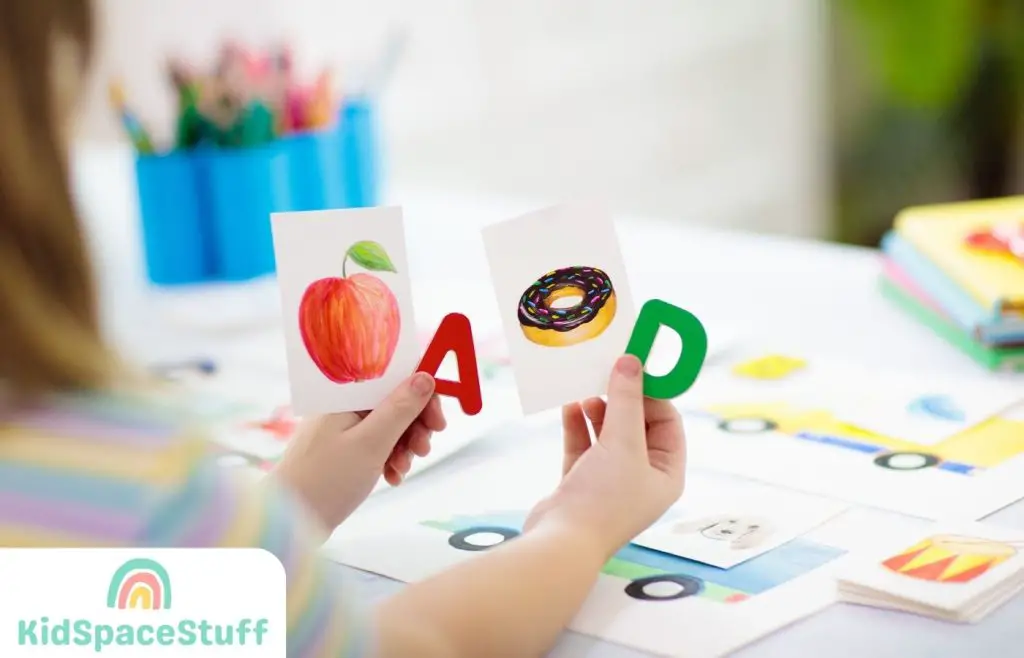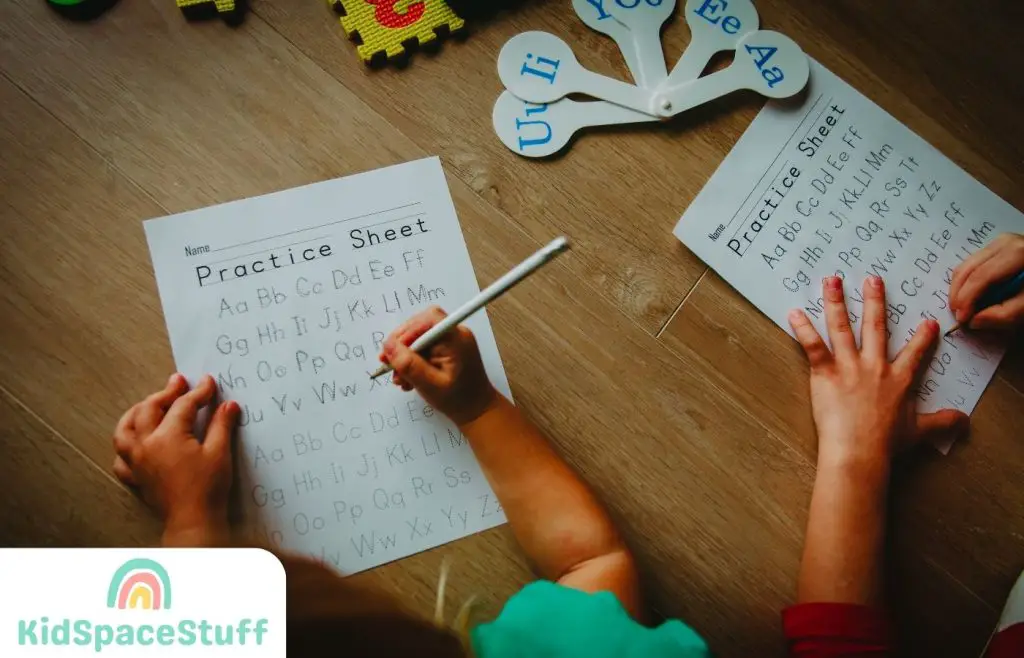As a mother of multiple kids, my children’s learning journey has been a constant adventure, filled with wonder, excitement, and the occasional frustration.
One of the most fundamental steps in this journey is the moment your child learns the alphabet.
When it comes to this exciting milestone, you might be wondering, “When do kids learn the alphabet?”
In this post, Ill explore the intricacies of learning the alphabet, letter recognition, and more. Let’s dig in!
When Do Kids Learn ABCs?

My eldest, a vivacious eight-year-old, began showing interest in alphabet letters around the age of two. This was about the time she started recognizing letters in her name, on billboards, and even on her favorite cereal box.
Around the age of 2 to 4, most children develop a curiosity about the English alphabet, sparked by their burgeoning language skills.
However, this isn’t a one-size-fits-all journey.
If your child doesn’t show an interest at this age, that’s perfectly fine. Each child develops at their own pace, and the learning process should always be enjoyable, engaging, and pressure-free.
What is the Normal Age Kids Learn the Alphabet?
While many children will start to recognize letters around the ages of two or three, most kids learn the alphabet, including all the letters in uppercase and lowercase, between the ages of four and five.
This is when they can usually sing the alphabet song and begin to associate letters with the sounds they represent.
At four, my middle child could connect letters with corresponding words. She knew that ‘C’ was for ‘cat,’ ‘D’ was for ‘dog,’ and ‘M’ was for ‘mom.’ A year later, she had no difficulty distinguishing between similar letter shapes like ‘B’ and ‘D.’
If your child is past five and still struggling with letter recognition, it’s essential to remember that children develop at different paces. It’s completely normal and not a cause for concern. Rest assured, they will eventually learn the alphabet.
How to Teach Kids the Alphabet
Here are some great ways I’ve used to help children learn letters and the alphabet!
Make Learning Fun

Creating a joyful and entertaining environment for learning is crucial when teaching kids the alphabet. One strategy that has always been successful with my children involves engaging them with a variety of alphabet games, songs, and puzzles.
Alphabet songs, in particular, are a great tool for teaching letters.
In our household, singing alphabet songs has always been a cherished activity. It’s an engaging way for kids to learn the sequence of letters in the English alphabet while also improving their phonics skills.
Alphabet games are another great tool to help your child learn the alphabet easily.
Games like letter scavenger hunts or matching letters can reinforce the recognition of individual letters. Alphabet puzzles can also be an effective teaching aid, not only for recognizing different letters but also for developing fine motor skills.
By incorporating these multisensory activities into your child’s learning routine, you’ll ensure that the process is fun, immersive, and less like traditional schooling, which can sometimes feel overwhelming for little ones.
Use Visual Aids
Visual aids play a critical role in teaching letters, basic math skills like counting, and certainly colors.
I’ve found that colorful flashcards, alphabet books, and alphabet blocks greatly facilitate the alphabet learning process. My youngest, who is now three, particularly loved flashcards. The vibrant pictures captivated her attention, making it easier for her to recognize sight words and associate letters with corresponding images.
Letter magnets on the fridge have also been a hit in our home. They offer an everyday opportunity to interact with letters, reinforcing visual memory. Even simple tools like sandpaper letters can be great for tracing, allowing children to feel the shape of each letter, enhancing their understanding of letter shapes.
When you consistently use visual aids, you’ll find that your child learns to recognize letters and decode words more effectively.
Need help teaching your kids the alphabet? Check out the video below!
Read Together
In our home, reading together is a cherished ritual.
By using alphabet books, children get exposed to more letters and the various sounds each letter makes. Reading not only strengthens their phonics skills and reading skills, but it also reinforces the relationship between letter sounds and their visual symbols.
During our reading time, I’d point to individual letters and emphasize the sound each one makes. This method helps in establishing a solid understanding of the letter-sound relationships.
Moreover, reading together is an excellent opportunity to bond with your child. It’s an intimate activity that not only enhances your child’s alphabet skills but also fosters a love for reading, which will be beneficial in their future academic performance.
Teach Through Everyday Activities
Incorporating learning into everyday activities can significantly boost your child’s progress in learning the alphabet. The world around us is full of written text, providing plenty of opportunities to teach kids to recognize and connect letters.
For instance, while at the grocery store, I would point out letters on product packaging or signs. At home, we would spell out everyday words, like ‘B-E-D’ for bed or ‘T-O-Y’ for toy. The key is to make the most of your daily routines to provide learning opportunities.
Setting up fun activities like letter scavenger hunts is another great way to help children learn. The excitement of finding ‘hidden’ letters around the house or garden can make learning incredibly enjoyable. This method not only helps children recognize letters but also helps them connect letters to form new words.
Remember, everyday life is teeming with opportunities to learn and explore. It’s all about turning the mundane into an exciting learning adventure!
Patience and Consistency are Key
Patience is essential because every child learns at their own pace.
Some children may pick up alphabet skills quickly, while others might take more time to grasp letter recognition or letter sound relationships. It’s perfectly okay, and it’s important to let your child learn at their own speed without undue pressure.
As a mom, I’ve learned to celebrate every little success, whether it was correctly recognizing a difficult letter or correctly spelling a word for the first time. These small victories, acknowledged and celebrated, boost their confidence and motivate them to keep learning.
Consistency, on the other hand, is key to ensuring steady progress. Even when it seems like your child is not making noticeable advancements, remember that learning is often happening behind the scenes. The connections being made in their little brains require regular reinforcement, so ensure that you consistently provide learning opportunities.
Encouraging Writing Skills

Once your child has mastered recognizing and reciting the alphabet, it’s time to introduce writing skills. Encouraging your child to write letters helps to reinforce what they’ve learned about letter names and shapes, and also aids in fine-tuning their motor skills.
In the early stages, I would guide my children’s hands as they tried to write letters. I would help them trace the letters in the air, on paper, and even in a tray of sand or shaving cream. These multisensory activities are especially helpful as they allow children to understand and remember the shape of each letter better.
When to Seek Help
If your child is significantly struggling with alphabet recognition past the age of six, consider consulting with your child’s teacher, a pediatrician, or an educational specialist.
Persistent difficulties in recognizing letters might indicate a learning disability. However, early intervention can help manage any potential challenges effectively.
Final Thoughts
Learning the alphabet is one of the most fundamental skills your child will acquire.
Witnessing your child’s literacy skills blossom is a moment of immense joy and pride. Remember, patience, consistency, and creating a fun learning environment are key to helping your child learn the alphabet.
Every child learns at their own speed, and that’s perfectly okay!
Wondering when kids learn other skills? Check out these articles!
KidSpaceStuff is a site dedicated to helping parents find the best interior design, activities, and inspiration for their kids.